Medical plastics play crucial roles in medicine. It refers to the type of plastics produced to fit the needs of medical uses, as they meet conditions such as biocompatibility, hardness, and flexibility. So let’s view the types of medical plastics and their diverse uses in the medical field as below.
Read more: What is plastic? Everything you need to know about plastic
1. What Is Medical Plastics?
Medical plastics can be defined as a type of polymer designed and developed according to applications in the medical industry. These plastics find applications in almost any field related to the medical industry, from single-use articles and devices to implants and prostheses. Key characteristics of medical plastics are:
- Biocompatibility: Medical plastics are prepared such that they are biocompatible, meaning they will not cause any harmful reaction or toxicity on application to the human body.
- Sterilizability: These plastics are heat resistant; they can be subjected to autoclaving, gamma radiation, or ethylene oxide so that they do not harbor bacteria.
- Mechanical Properties: Medical plastics are designed to possess desired mechanical properties to attain specific applications in medical procedures such as implantation, syringes, tube-like structures, and many others.
- Chemical Resistance: Medical plastics are chemically stable and thus can withstand the chemical aggression of various disinfectants, body fluids, and pharmaceuticals so that they retain their characteristics.
- Transparency: Most medical plastics offer good clarity for most of the medical devices that have to be inspected and monitored visibly.
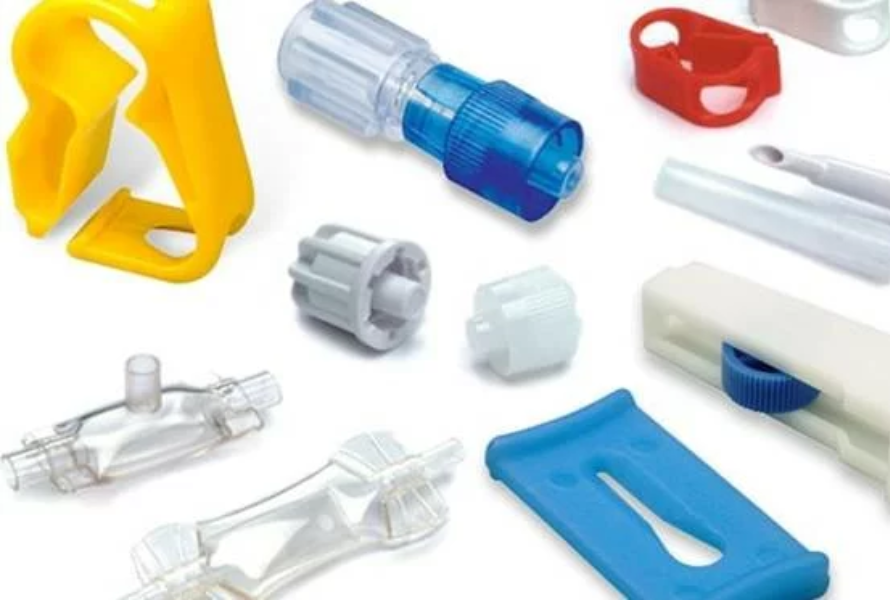
A type of polymer developed with special features for applications in the medical business is known as medical plastics.
2. Overview Of Medical Plastics’ Market Demand
The market size of medical plastics worldwide was worth $52,9 billion in 2023 and is expected to exhibit a CAGR of 7,4% during the period of 2024-2030. Thanks to new advanced plastics and plastic-based materials, this market is growing rapidly, including applications in medical devices such as catheters or surgical instruments.
Other factors contributing to the growth of the medical device packaging market include increased use of in-house and advanced medical devices resulting in higher demand for associated packaging materials. These medical devices are some of the most valuable products made from polyethylene, polypropylene, and polycarbonate, among other plastics.
The home healthcare demand also has expanded this market due to its lower cost compared to traditional hospital care services for the medical plastics market. Medical professionals and patients seek medical devices that are portable, light in weight, and easy to operate, thus creating the need for advanced medical plastics.
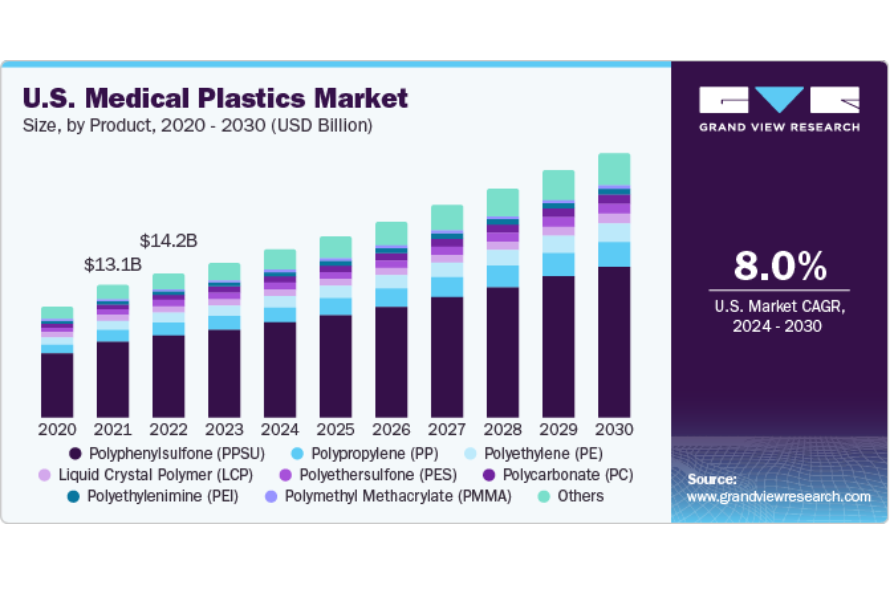
According to Grand View Research, the medical plastic market is expected to grow from 2024 to 2030.
3. Common Types Of Medical Plastic
3.1. Polyethylene (PE)
Polyethylene is among the types of medical plastics that are most popular due to its versatility across the healthcare sector. Its wearability, strength, and nonabsorbent features make it suitable for different medical application products and packaging.
Based on the characteristics of the material that is to be shaped, high density polyethylene (HDPE) or low density polyethylene (LDPE) is used. Syringes, IV bags, and medical tubing are made from HDPE and LDPE and medical tubing is made from LDPE, flexible packaging.
3.2. Polypropylene (PP)
Polypropylene is widely used in the production of medical devices thanks to its favorable mechanical characteristics, thermal stability, as well as sterilizability. Although it is widely used in a wide range of applications, it is most frequently employed in the production of syringes, catheters, and other medical devices.
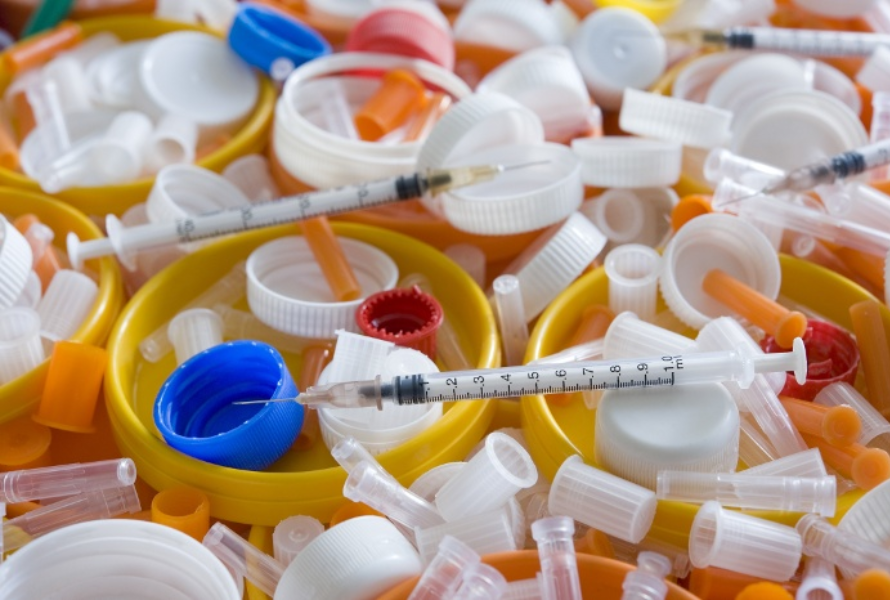
Because of its good mechanical properties, polypropylene is still often employed in the manufacture of medical plastic equipment.
3.3. Polyvinyl Chloride (PVC)
PVC is another medical plastic that is also widely employed in the construction of medical tubing and IV and blood bags. PVC has enjoyed flexibility, and durability in addition to its chemical resistivity hence making the material right for use where there will be extended exposure to body fluids or medications.
3.4. Polycarbonate (PC)
Polycarbonate is a medical plastic that can make high-temperature demands and has the features of high transparency, high impact strength and dimensional stability. It is increasingly being applied in different industries, especially the medical one, in components of medical applications like blood monitoring devices, syringes, and housings.
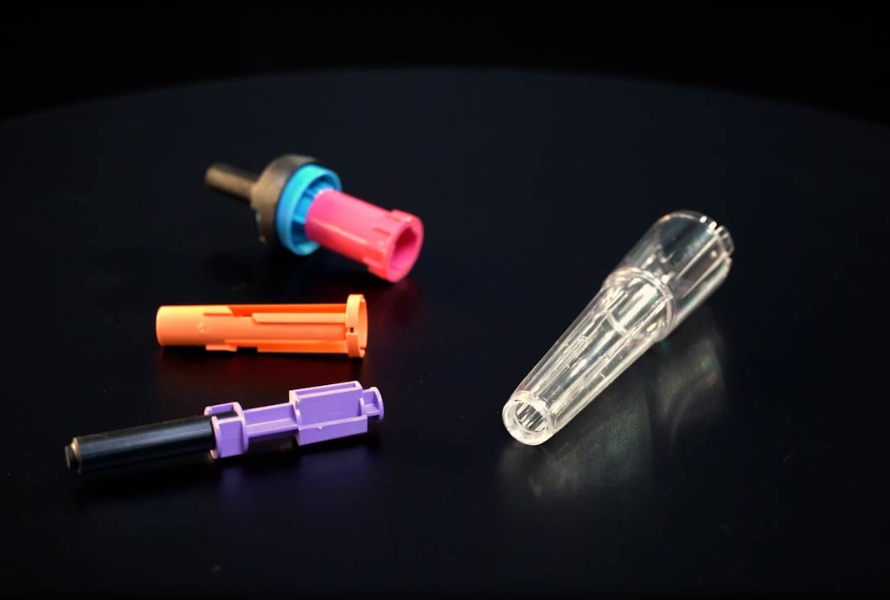
Polycarbonate with high-temperature demands is a medical plastic widely being applied in different industries.
3.5. Polymethyl Methacrylate (PMMA)
As it has been seen, PMMA (Polymethyl Methacrylate) occupies a significant share of the medical plastics market. Due to its light transmission ability, biocompatibility, and resistive mechanical characteristics, PMMA is a useful and commonly applied plastic material with multifaceted applications in the medical plastics sector. It is incorporated in a broad range of medical applications such as catheters, dialysis, and hardware parts for surgery.
4. Benefits Of Medical Plastic Parts In Healthcare
4.1. Sterilization
Medical plastics can be resistant to different sterilization methods, and that is a major advantage especially when the plastic material will be used in the health sector. The plastics employed in the production of medical devices and equipment in question are capable of being sterilized through autoclaving, gamma radiation, or ethylene oxide treatment in order to preclude contamination.
This sterilizability indicates that the medical plastics used can be applicable to both disposable and reusable products, while the hygiene and safety of the patients are well protected. The sterilization process also makes it possible to ease cleaning and reprocessing of medical devices thus increasing their life cycle and value for money.
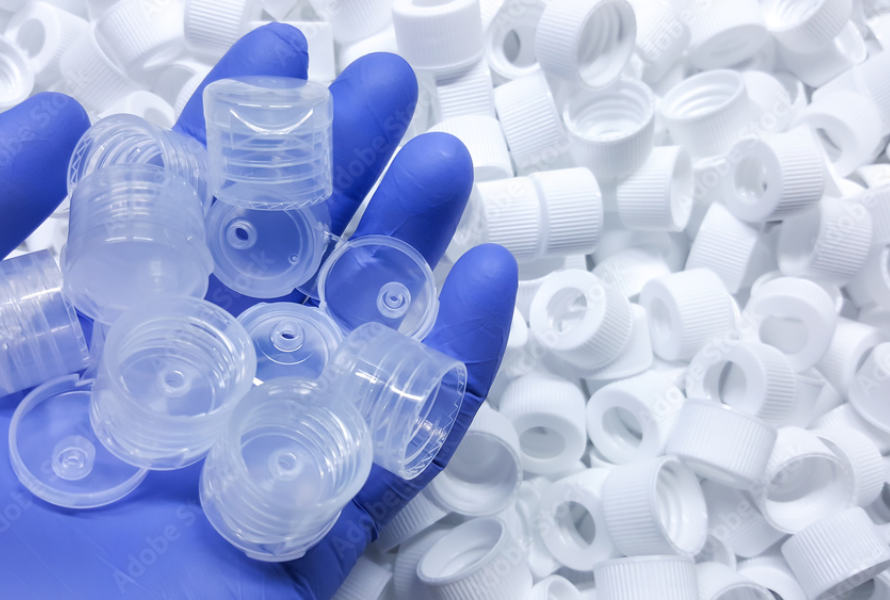
One significant benefit of medical plastics is its resistance to various sterilization techniques.
4.2. Design Flexibility
Another advantage that can be attributed to medical plastics is that medical plastics products are very flexible in design, which is a major plus in the medical field. These materials can be bent, shaped, and cut into different cross-sections, making it possible to come up with complicated and intricate designs for advanced medical tools and parts.
On this premise, healthcare professionals reap the benefits of customized and specialized products depending on their requirements, for instance, the design of a particular surgical instrument or even the physiology of an artificial limb.
4.3. Cost-effectiveness
In contrast to metals or ceramics which are conventionally used, medical plastics are normally cheaper to make especially for consumable products like disposable sanitary products or a one-time-use medical product. This can ultimately lead to improvement in the accessibility and availability of medical care as it brings the cost of essential healthcare products down.
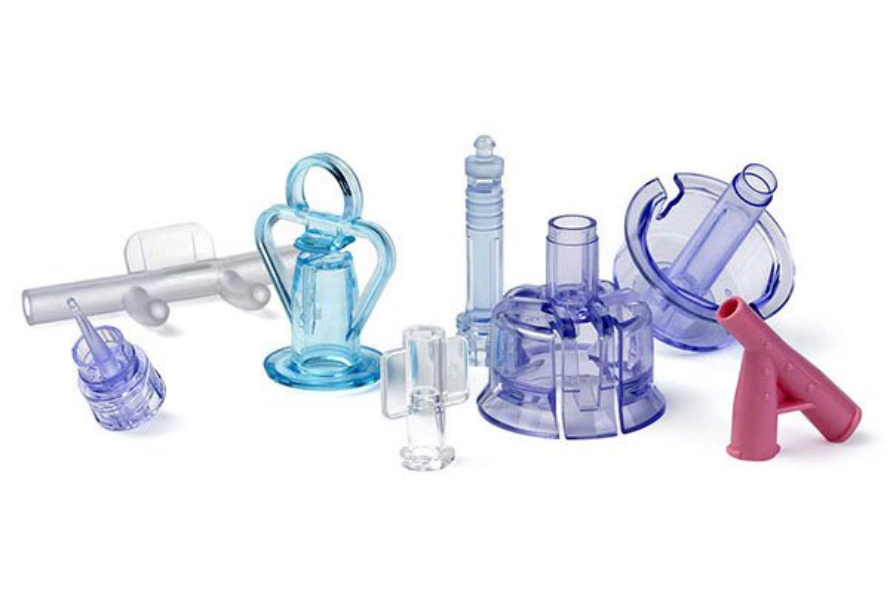
In general, medical plastics are less expensive to produce, particularly for consumable goods.
4.4. Lightweight and portability
Medical plastics are light by their nature, which is beneficial when it comes to transportable medical tools and equipment, whether it is during an emergency, when a patient is being transported, or during the normal flow of a healthcare facility.
5. Different Applications Of Medical Plastic In Healthcare
5.1. Surgical instruments and equipment
Medical plastics play a crucial role in the manufacturing of a wide range of surgical instruments and equipment. Scalpels, forceps, clamps, and other surgical tools are often made from durable, sterilizable plastic materials that can withstand the demands of the operating room.
These plastic components offer excellent precision, strength, and ease of handling, allowing surgeons to perform exact procedures. Additionally, medical plastics are used to create trays, basins, and other equipment used during surgical procedures, as well as protective gear like masks, gloves, and gowns that help maintain a sterile environment and safeguard healthcare workers.
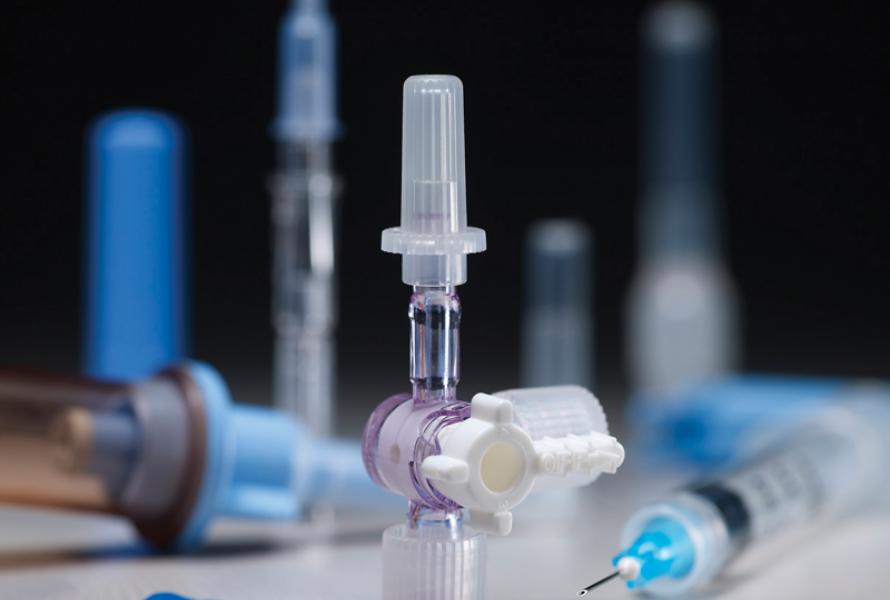
A large variety of surgical instruments and equipment are manufactured using medical plastics.
5.2. Implants and prosthetics
The biocompatibility and durability of medical plastics make them indispensable in the field of implants and prosthetics. Joint replacements, such as hip, knee, and shoulder implants, often incorporate plastic components that provide a smooth, low-friction surface for improved mobility and reduced wear.
Cardiac devices, including pacemakers, defibrillators, and artificial heart valves, also rely on medical plastics for their structural integrity and compatibility with the human body. Orthopedic implants, like bone plates, screws, and pins, as well as dental implants and orthodontic appliances, are manufactured using specialized medical plastics that facilitate integration and healing.
5.3. Diagnostic and monitoring equipment
Medical plastics are essential in the production of a wide range of diagnostic and monitoring equipment. Blood pressure cuffs and tubing, syringes, needles, and other drug delivery devices, as well as blood collection tubes and sample containers, are commonly made from medical plastics.
These plastic components play a crucial role in ensuring the accuracy and safety of diagnostic procedures, while also enabling healthcare providers to monitor and treat patients effectively.
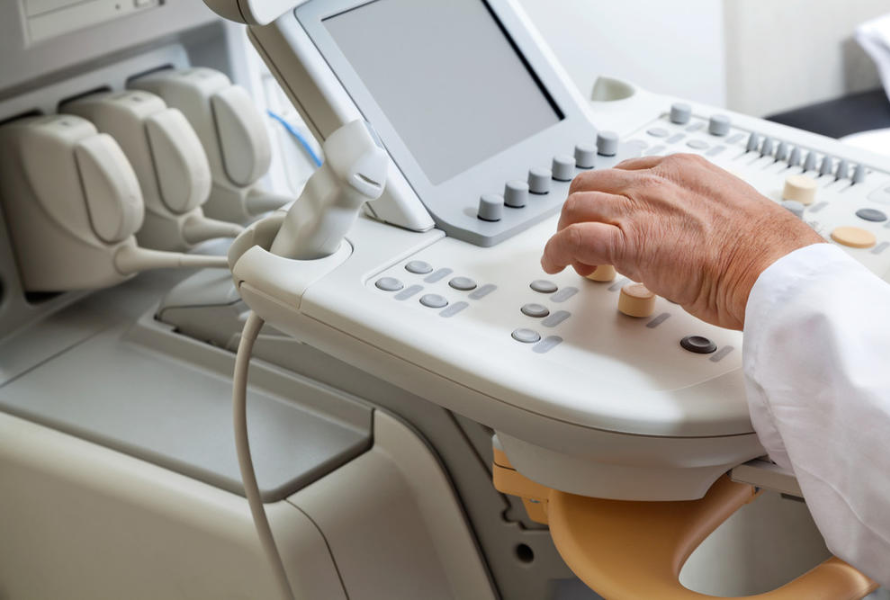
Medical plastics are necessary for the manufacturing of several monitoring and diagnostic devices.
5.4. Disposable Medical Supplies
The healthcare industry relies heavily on disposable medical supplies, many of which are manufactured using medical plastics. Syringes, needles, and catheters provide essential functionality while minimizing the risk of cross-contamination.
Bandages, dressings, and other wound care products leverage the versatility and cost-effectiveness of medical plastics to deliver effective patient care. Disposable gloves, gowns, and other personal protective equipment (PPE) made from medical plastics help safeguard healthcare workers and patients by providing a barrier against infectious agents.
6. Conclusion
Medical plastics offer unique properties and capabilities to meet the ever-evolving needs of the healthcare industry. As medical technology continues to advance, the medical plastics market is poised to play an increasingly crucial role in delivering innovative, high-performance solutions that improve patient outcomes and enhance the overall quality of care.
7. About EuroPlas
For many years now, many businesses have turned to EuroPlas as one of the most trusted companies dealing with plastic products. The plastic we supply at EuroPlas includes PP plastics for medical plastic manufacturing.
Kindly contact us for more information about this product.